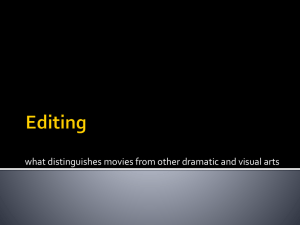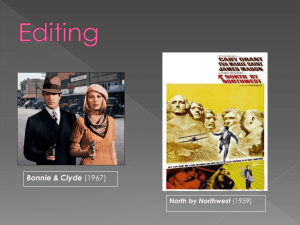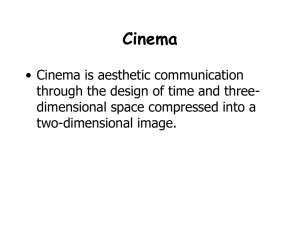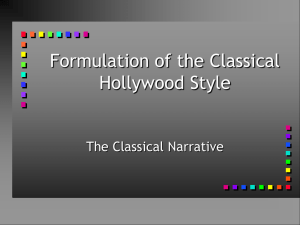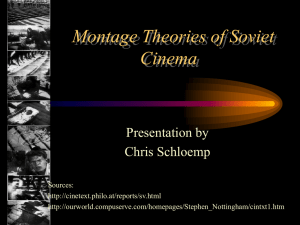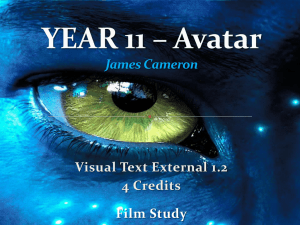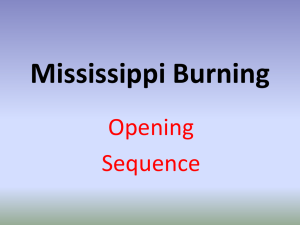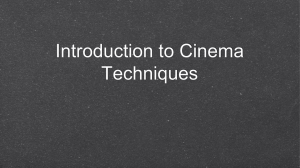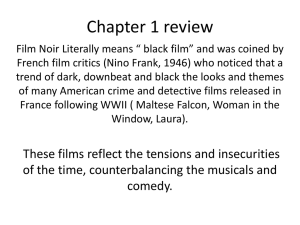Master Shot
advertisement
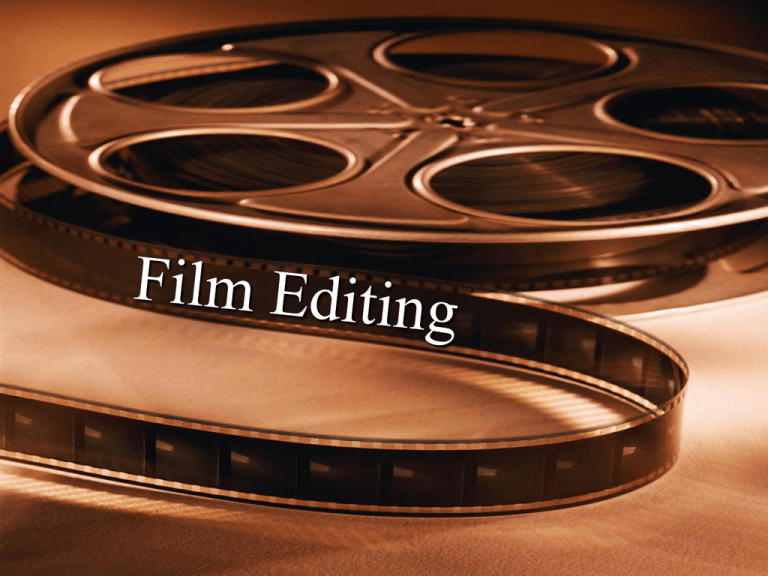
Master Shot Master Scene Technique Take Continuity Stock Shot Cut Fade Wipe Match Cut Jump Cut Montague Parallel Action Subliminal Cut Split Screen Cross Cut Cutaway Shot Final Cut Film Editing Definition The art of storytelling practiced by connecting two or more shots together to form a sequence, and the subsequent connecting of sequences to form an entire movie. It is often referred to as the "invisible art," since when it is well-practiced, the viewer becomes so engaged that he or she is not even aware of the work of the editor. Master Shot A shot which covers an entire piece of dramatic action. Editing often consists of inserting various shots into the Master Shot. Master Scene Technique A production technique where scenes are filmed from the widest shots to the narrowest. Master Shot of a scene showing all characters and is filmed from beginning to end. Then three shots, two shots, closeups and other inserts are filmed and edited into the master scene. Take Multiple versions of the same shot are called takes. Editors assemble movies by putting together the various takes produced during the production process. Continuity Continuity is a film term that suggests that a series of shots should be physically continuous, as if the camera simply changed angles in the course of a single event. The most common errors during a film are continuity errors. For instance, if in one shot a beer glass is empty, it should not be full in the next shot. Continuity Error Examples From Casablanca Rick's tie is suddenly knotted differently when he sees Ilsa in the bazaar. When Rick gets on the train after standing in the rain, his coat is completely dry. Continuity Error Example From Spider-Man In the scene where Mary Jane is being mugged by four men, SpiderMan throws two of the men into two windows behind Mary Jane. The shot switches to SpiderMan beating up the other two guys. When it cuts back to Mary Jane the two windows are intact. Stock Shot A sequence of film previously shot and available for purchase and use from a film library. Transitions Cut Transitions The simplest transition between shots it is a straight cut, which is an abrupt transition between two shots. Dissolve Transitions When one scene fades out as another scene fades in this is a dissolve. These dissolves are used frequently to indicate a passage of time. For example, you might have a shot moving down a hall and then a dissolve as it moves into a different part of the building. Fade Transitions A transition where the overall light of the scene increases or decreases into a frame of just one color. For example, a fade to black may indicate the end of the sequence. Wipe Transitions Another type of transition is when one scene wipes across the frame and replaces the previous seen. Wipes can move in any direction and open one side to the other or they can start in the center and move out or the edge of the frame and move in. Wipes are very noticeable and best not used often. Shot Visual Composition Use Match Cut A match cut is used to make the transition from one image to another as seamless as possible. The most common match cut is on the action. An action is started in one frame and finished in the next frame. This cut thus become transparent. The man reaches for his glasses in one frame and pull on them the next. Another way to match cut is on a look. When an actor shifts his eyes to look as something, cut to a new image. This is a natural transition because we experience the scene through the character’s eyes. It is nature for us to see something new as the characters looks around. Shot Visual Composition Use Match Subtle and Cut obvious the bread and butter of film editing an example comes in The Godfather: In The Godfather. during the baptism sequence, the priest takes some ointment with his finger and touches the child's lips. This is immediately contrasted when we see a barber squirt some shaving foam into his hand from a pump, and spreads it on a customer's face. This is a match cut, and made all the more effective as both are tracking shots that match. Jump Cut A cut where two spliced shots do not match in terms of time or place. A jump cut gives the effect that the camera is literally jumping around. The opposite of match cuts and the invisible art of film editing. In most films, directors and editors do their best to hide cuts. They cut when an actor occurs or eyes move and use cutaways. sometimes they want to express something (perhaps the nervousness of a character) and cut so is appear the characters jump from one part of the screen to another. This type of editing is quite noticeable. Where can one see Jump cutting in a film? In Breaking the Waves, many subtle jumps in space and time are used as Jump Cuts. In Godard’s Breathless, Jumps in time and space are made during the dialogue. Subliminal Cut A subliminal Cut happens very quickly. The film cuts from the first image to a new, impact image, and then cuts to a new, impact image, and then cuts back again. The new image last only a few frames and the audience gets only a brief glimpse of it. This technique works like a subliminal message, activating something in the viewer’s subconscious. Where can I see it? In The Exorcist, Father Karras sees the face of death as a subliminal cut after his mother’s death. In From Dusk till Dawn Subliminal cuts are used to show but not reveal a bloody murder scene In The Graduate, Subliminal Cuts or Mrs. Robinson’s body parts are used as she attempts to seduce Benjamin. Montag e A montage sequence, a segment which uses rapid editing, special effects and music to present compressed narrative information. In Rocky a Montage Sequence shows Rocky training for his big fight. Butch Cassidy and the Sundance Kid has a bicycle riding Montage Sequence. In Easy rider, sever Montague Sequences show the characters driving across the country. In the beginning of Mimic, a Montage Sequence presents the images that fade in and out to present an ominous, chilling introduction. Montage examples can be seen in the following films: Butch Cassidy and the Sundance Kid To Sir With Love Bonnie and Clyde Ferris Bueller’s Day Off Pulp Fiction Almost Famous Pleasantville Cinderella Man Zelig Parallel Action Film Editing device of narrative construction in which the development of two pieces of action are presented as taking place simultaneously . Two techniques for development of Parallel Action is the use of Cross Cutting and Split Screen. Split Screen A Split Screen shows two separate sequences on the screen at the same time. fore example: the image can be split down the middle, allowing one scene to occur on the left side and another to occur on the right. The frame may be split into halves, quarters, whatever, depending on what the director wants. Both When Harry Met Sally and Indiscreet use a Split Screen as two lover talk on the phone. At the end of Carrie, a Split Screen showcases the hellish prom diaster. Split Screen Cross Cutting Effect Film Editing Use An editing technique used in films to establish continuity. In a cross-cut, the camera will cut away from one action to another action. Because the shots occur one after another, cross-cutting is used to suggest simultaneity of action. Cross-cutting was made famous by Edwin S. Porter's 1903 film, The Great Train Robbery. Cross-Cutting The editing technique of alternating, interweaving, or interspersing one narrative action (scene, sequence, or event) with another - usually in different locations or places, thus combining the two; this editing method suggests parallel action (that takes place simultaneously); often used to dramatically build tension and suspense in chase scenes, or to compare two different scenes; known as inter-cutting or parallel editing. Examples of Cross-Cutting Edwin S. Porter's The Great Train Robbery is the first film to use Cross Cutting. D. W. Griffith's The Birth of a Nation (1915) The finale of Griffith's Intolerance (1916), features a chase to save the pardoned hero from execution in the modern story is cross cut with Christ's procession to Calgary. Cross Cutting may be seen in virtually every movie. In A Better Tomorrow, John Woo cuts back and forth between the image of an assassin approaching his victims in slow motion and the victims sitting obliviously in a table in real time. In Rocky, Cross Cuts contrast the training styles of Rocky and Apollo Creed. In Batman, the camera cuts between the Joker dancing and batman fighting. In The Good, The Bad and the Ugly, notice the Cross Cuts between soldiers marching, Clint Eastwood assembling his gun and the assassins approaching. Examples of Cross-Cutting In The Godfather, during Michael's nephew's baptism, we see the priest performs the sacrament of baptism at the same time the film cross –cuts so we see killings ordered by Michael take place elsewhere. The murders thus "baptize" Michael into a life of crime. Cut away shot Brief shots that momentarily interrupt a continuously-filmed action, by briefly inserting another related action, object, or person Reaction shots are usually cutaways The view of the roulette number being bet upon in Casablanca is a cut away shot. Sometimes (often) A Cutaway is used in film editing process to hide mistakes. The Editor may compose film in this order: Sequence 1, Cutaway, Sequence 2. Because the images cuts away to an intermediate object, the viewer doesn’t notice the awkward transition between the two sequences. Final Cut The finished edit of a film, approved by the director and the producer. This is what the audience sees. The End
